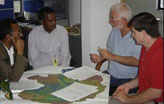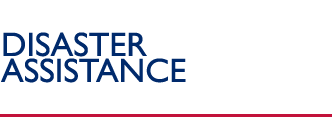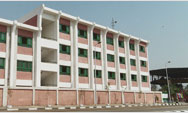Humanitarian Sectors Funded by USAID's Office of U.S. Foreign Disaster Assistance (OFDA)
|
|
|
|
| |

|
Agriculture and Food Security
Emergency agriculture and food security initiatives address immediate needs of target populations and strengthen local capacity and resilience to disasters. USAID supports agriculture and food security activities that expand choices available to farmers. USAID also funds the improvement of seed assessment methodology, provides assistance for emergency pest and pesticide management and disposal, and encourages the multiplication and dissemination of disease-resistant crop varieties. |
| |

|
Economy and Market Systems
In the wake of a disaster, USAID focuses on supporting programs that contribute to the longer-term economic recovery of a region by assisting people to resume their livelihoods. Such programs seek to restore livelihood assets, provide grants to support small business development, and create employment opportunities for people affected by disaster. Economic recovery is a vital part of the longer-term rehabilitation of a community following a disaster and an integral piece of a holistic, comprehensive disaster response program. |
| |

|
Health
USAID supports emergency health interventions that are based on strategies with the highest public health impact for the majority of those affected. Health interventions emphasize community-based initiatives that address major causes of death and disability. Such programs are designed to help prevent and treat malaria, measles, diarrhea, acute respiratory tract infections, and malnutrition. USAID programs increase pregnant women’s access to safe maternal health care and provide education on caring for a newborn. USAID health activities are coordinated with local governments and implementing partner health strategies. |
| |

|
Humanitarian Coordination and Information Management
In any humanitarian response, coordination and information management are essential elements for the delivery of humanitarian assistance in a cohesive and effective manner. Through U.N. and non-governmental organization (NGO) partners, USAID provides funding to enhance international and local coordination mechanisms. USAID also supports activities to strengthen the coordination and information management infrastructure of the international humanitarian community as a whole. |
| |

|
Logistics and Relief Commodities
USAID maintains stockpiles of emergency relief commodities, such as plastic sheeting, blankets, water containers, and hygiene kits, in three warehouses around the world. To ensure that disaster-affected populations receive sufficient relief supplies, USAID manages the provision and delivery of warehoused commodities and also funds implementing partners to procure relief supplies locally. USAID distributes humanitarian commodities based on detailed needs assessments, often in coordination with other donors and/or NGOs. |
| |

|
Nutrition
USAID supports emergency nutrition programs that focus on the prevention and treatment of moderate and
severe acute malnutrition. Programs funded by USAID use evidence-based approaches that decrease morbidity and mortality from malnutrition and from health
conditions exacerbated by malnutrition. USAID supports activities that are community-based and linked to local health systems. |
| |

|
Protection
Protection activities assist internally displaced persons and other vulnerable populations
in reducing or managing risks associated with violence, abuse, harassment, and exploitation. OFDA strongly
encourages implementing partners to mainstream protection considerations into the design, implementation,
and evaluation of assistance programs wherever possible and appropriate. Since 2005, USAID has funded protection of vulnerable populations as a stand-alone humanitarian sector. |
| |
|

|
Risk Reduction (Natural and Technological Disasters)
The vulnerability of communities located in hazard-prone areas places them at a higher risk of casualties and damage from technological, hydro-meteorological or geological hazards. USAID works closely with vulnerable communities as well as with national governments, international and regional organizations, and NGOs to identify, manage, and reduce vulnerability of populations to such hazards through encouraging multi-sectoral linkages.
|
| |

|
Shelter and Settlements
In the wake of a major disaster that damages and destroys homes, USAID provides shelter and
settlement assistance to address both immediate needs and overall recovery and reconstruction. Where possible and appropriate, shelter
interventions promote livelihood opportunities and support and sustain local coping mechanisms. Program design emphasizes separate spaces for women and children, utilization of local building materials, re-use of rubble, and basic site planning to provide privacy and dignity. |
| |
|

|
Water, Sanitation, and Hygiene
In disaster-affected areas, USAID funds water, sanitation, and hygiene (WASH) interventions such as the construction of wells and latrines and the promotion of hand washing, safe water usage, and healthy sanitation. To ensure sustainable programs, USAID links emergency activities with transition and development programs and incorporates institutional partners such as local governments in program planning and implementation. Through WASH programming, USAID helps reduce morbidity and mortality associated with water and sanitation-related diseases and poor environmental conditions. |
| |


